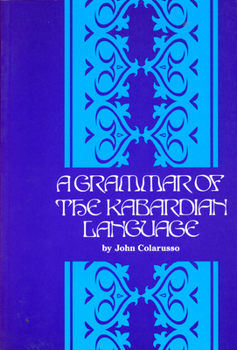Grammar of the Kabardian Language
This is the first comprehensive grammar of a non-Indo-European language from the Northwest Caucasian family in a language other than Russian. Kabardian is complex at every level. The language treated is not the literary standard, but Kabardian as it was found in texts and in the mouths of Kabardians. This study is an advance over grammatical sketches of related languages in that it gives a complete account of the phonology and morphology of the...
Format:Paperback
Language:English
ISBN:0919813968
ISBN13:9780919813960
Release Date:December 1992
Publisher:University of Calgary Press
Length:254 Pages
Weight:0.95 lbs.
Dimensions:0.7" x 5.5" x 8.5"
Related Subjects
Foreign Language Foreign Language Study & Reference Foreign Languages Language ArtsCustomer Reviews
2 ratings
A complex language not fully demystified
Published by Thriftbooks.com User , 14 years ago
Although surrounded by the Eurasian lingustic area, the unique Northwest Caucasian languages have almost nothing in common with the languages families - Indo-European, Uralic, Afroasiatic, Turkic, Mongolic, Dravidian - that dominate this area. In most respects, with their small vowel inventories and polysynthetic word structures, the Northwest Caucasian languages have much more in common with Native North American languages. Yet, Northwest Caucasian languages possess a remarkable number of traits not found even in Native American languages, from their three- or more-place verbal agreement to their complex phonology whereby vowels on the surface can be realised in many different sounds depending on the following consonant, which is a trait not found even in languages like Haida and Nuuchahnulth which share the same trait of impoverished vowel systems allied to huge consonant inventories. "Grammar of Kabardian Language" was the first book in English on a Northwest Caucasian language apart from Hewitt's 1979 study of Abkhaz, and is quite fascinating even for someone with a limited idea of how these languages work. What is revealed very well if with not enough examples are the intricacies of Kabardian phonology - especially how the two vowels change their actual sounds, with examples. The extremely complicated verb structure is also dealt with very well: what is particularly exotic about Kabardian to English ears is how a single word can form as effective a sentence as many arguments because the verb must agree with every argument in the clause it governs. The relatively simpler noun and postpositional structures are not dealt with so well: there could have been more examples provided to help the general reader like myself. A problem all along is that the relationships between surface and underlying structures - which as noticed above is extremely complicated in Kabardian - needs to be far more consistently explained than it actually is, with the result that often the reader will not understand the surface structure unless (s)he goes very far towards learning the language. On the plus side, Colarusso does a good job of explaining Kabardian culture and how it (might) relate to the language they speak. It is refreshing when he explains the honor culture and blood feuds that result from the Kabardians' tradtional herding economy, and how this has been influenced by Islam over time (the Kabardians converted to Islam in the seventeenth century). All in all, even if its layout is not adequate to completely demystify an exotic language, I can still recommend "Grammar of Kabardian Language" to the linguistics reader, as it does offer a good deal of valuable information.
Kabardian
Published by Thriftbooks.com User , 23 years ago
I love Kabardian. It is the best language in the world.





